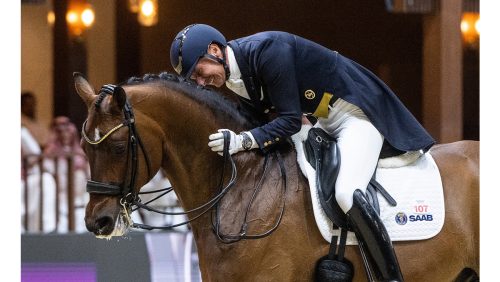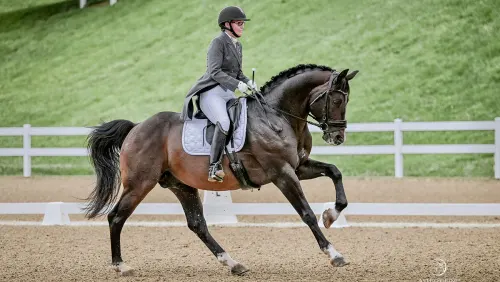Wellington, Fla.—Dec. 29
The riders and auditors at the Robert Dover Horsemastership Clinic expected to watch and learn from top caliber instructors such as Olympians Dover, Debbie McDonald and Michael Barisone, but Dover had another vision in mind.
“I’ve asked a lot of the riders here, I say, ‘What are you seeing?’ And they say, ‘Nothing,’ ” Dover said. “If you’re only seeing with your eyeballs you’re just seeing what’s happening. You need to use your inner vision to see what you’re about to ask for.”
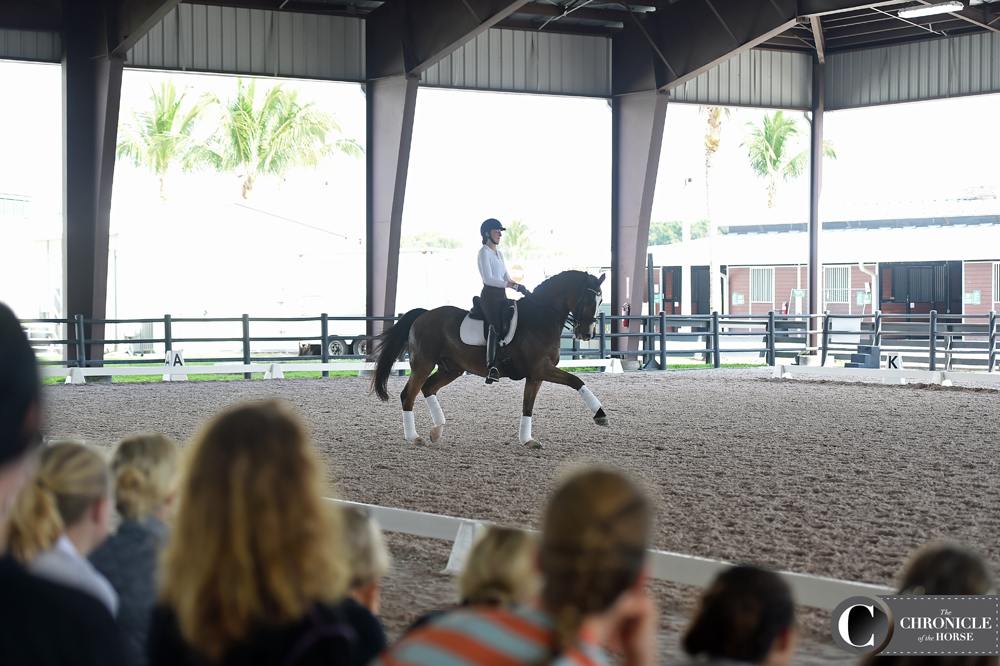
Maddie Lacy demonstrates the extended trot aboard Oublette in her lesson with Michael Barisone. Photo by Ann Glavan.
Eighteen young riders took part in Thursday’s clinic sessions, with Dover, McDonald and Barisone each teaching six private lessons. And while the lessons certainly focused on the physical tools to improve their rides in the future, for Dover it was just as important that riders be able to envision the reaction they want from their horses before they head down the next diagonal.
Go Forward To Collect
What one thing did these Olympians keep coming back to throughout the day, no matter the issue in front of them? Forward energy. If a rider was running into trouble in the collected movements, nine times out of 10 it stemmed from a backwards feel.
“It’s all about the collection of energy that wants to extend, that’s what a collected trot is,” Dover said while teaching Hannah Irons on her pony My Lucky Charm. “Everything is an extended trot that you’re collecting. Your horse should be saying all the time, ‘Do you want an extended trot? Do you want a passage?’ and you tell him, ‘No buddy, not now, you just stay here with me,’ but you feel that at any moment the next step could be extended trot.”

Hannah Irons rides her pony My Lucky Charm in a lesson with Robert Dover. Photo by Ann Glavan.
Dover used a metaphor to illustrate his point.
“If I have a sling shot, the more I take away from it, the more I pull back, which direction does it want to go? It wants to shoot forward,” Dover said.
Dover and McDonald used the phrase, “Add, don’t subtract,” when it came to bringing a horse back to collection from the extension, meaning that the collected work should actually require more leg and energy than the extended work. It’s not just a “little trot.”
“You’re pulling him to collect him; you need to push him into the collection!” Dover told Alison Hopkins.
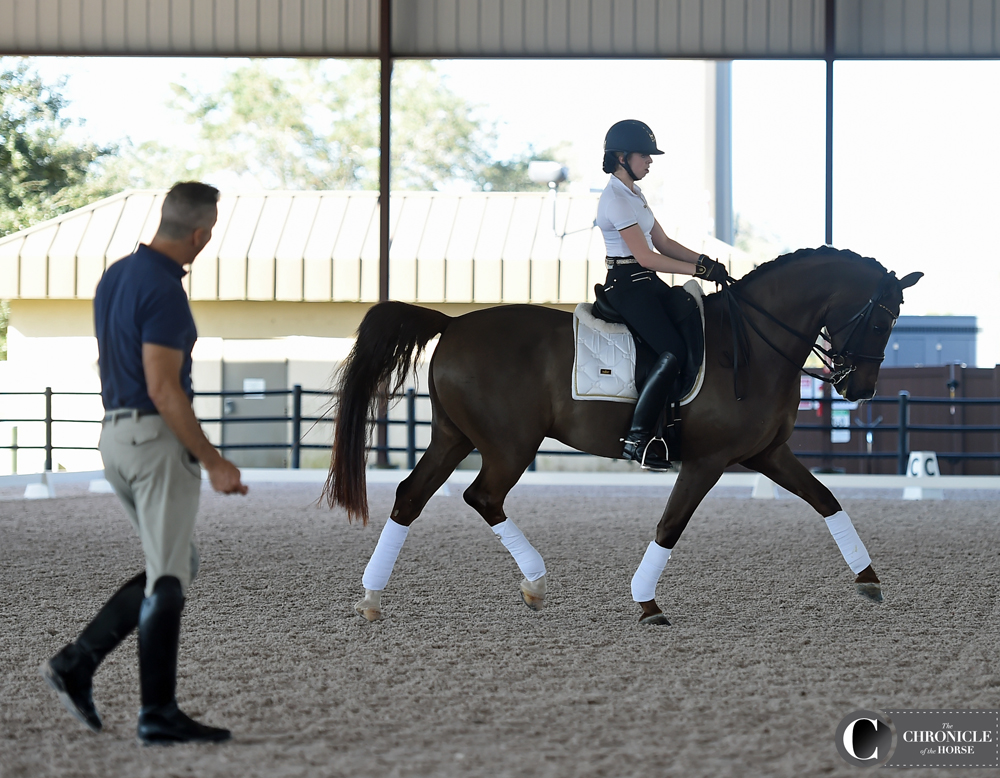
Robert Dover coaches rider Alison Hopkins through his “rubber band” exercise. Photo by Ann Glavan.
On Connection
Whenever Dover hops aboard an unfamiliar horse, he uses a test to determine the connection.
“I ask myself, ‘Do I feel the extended trot in this walk? Do I feel the halt? Could I extend or halt the very next step?’ Feel all the potential things in this gait, feel all the things,” Dover said.
He had Hopkins do several transitions from walk to a passagey trot to sharpen the connection with her horse before having her start what he calls the rubber band exercise, one of his favorite warm-up movements. It involved transitioning from extended trot to a few steps of passage on a large circle.
ADVERTISEMENT
Dover also insisted riders not simply spur their horses forward if they didn’t react to the aids correctly the first time. “When our horse gets behind us a lot of times you’ll hear, ‘Just send them forward,’ and instead of balling up the energy we just fling it out in front of us,” he said. “It’s like an electric circuit; if you break the circuit you lose the energy.”
Dover wanted riders to hold the connection and push their horses forward into it instead of allowing them to shoot forward.
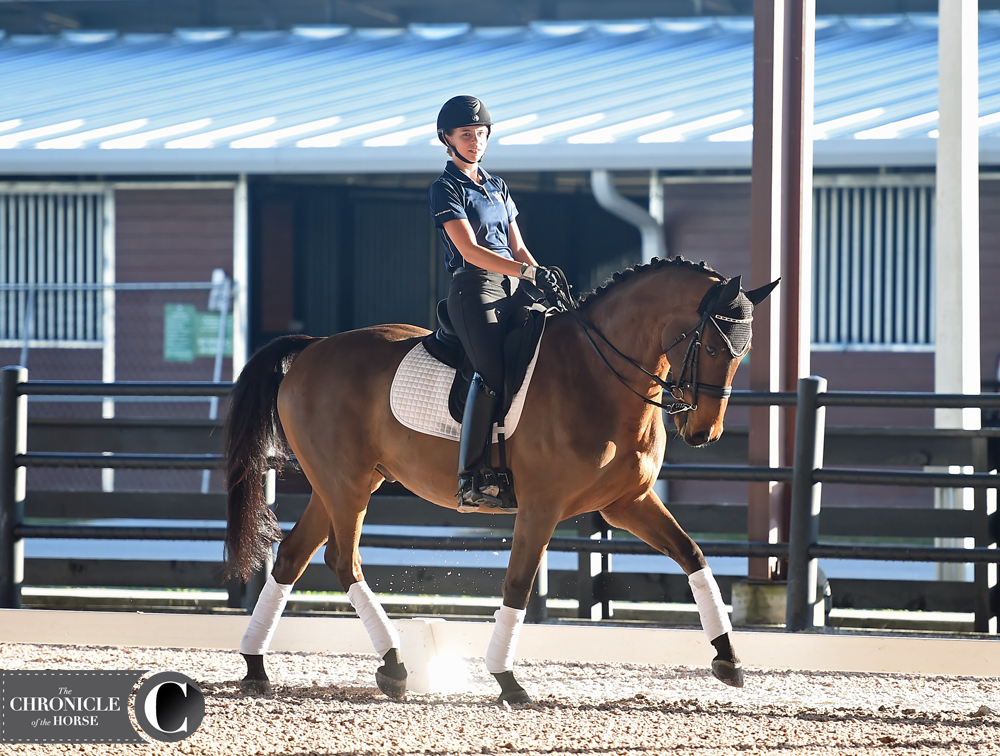
Michael Barisone focused on the driving seat with rider Amelia Devine on Perazzi DS. Photo by Ann Glavan.
Barisone echoed this when he insisted riders stay sitting in the extended trot, even if they ran into trouble.
“In any discipline, eventing, jumping, dressage, you’ve got to be able to put your leg on and push the horse forward,” Barisone said. “Horses need to accept your driving aid.
“You sat, and he backed off,” Barisone told rider Amelia Devine. “When you sit he needs to go forward!”
McDonald helped several students with the volume of their aids, explaining that while it was important that the horse listen promptly, it was also important not to over-do it.
“You don’t need to yell, you need to whisper,” McDonald said.
McDonald also helped Alison Nemeth keep a better connection with her horse through the flying change, insisting that Nemeth not over-bend her horse. “The neck position isn’t what makes him change; it’s your leg and his balance,” McDonald said.
McDonald focused Nemeth on getting her horse’s balance more correct and uphill. “When you get the basic balance and connection correct, then the tricks are easy,” McDonald said.
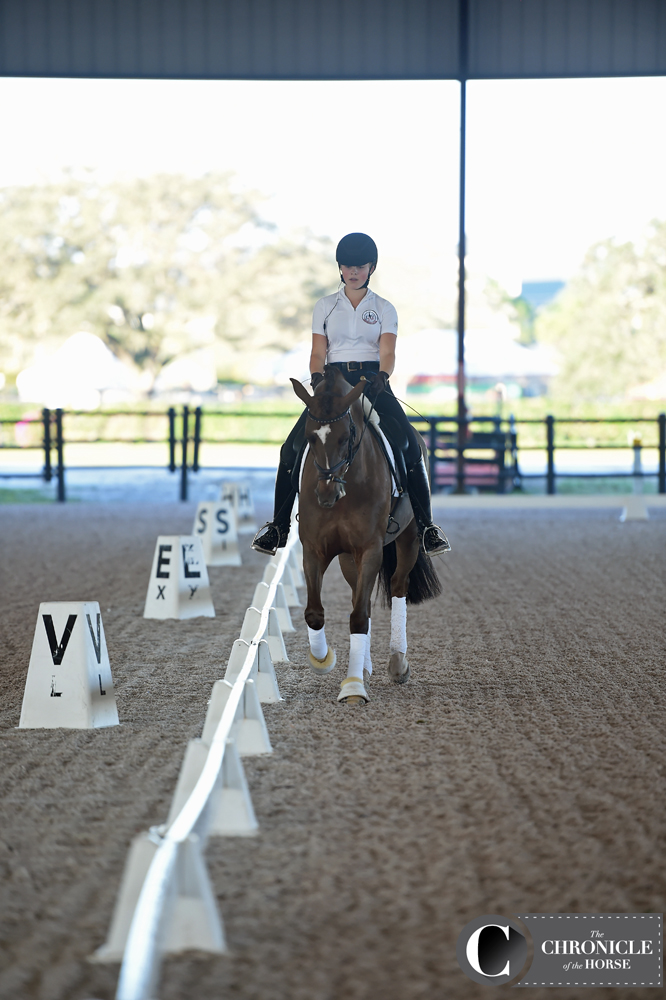
McDonald focused on lateral work with most all of her students to develop a better connection. Pictured here is Julia Barton and Bonnaroo. Photo by Ann Glavan.
On Young Horses
A few students rode young horses in the clinic, and Barisone helped rider Jackson Gillespie with his green mount when the gelding lodged some objections to moving forward into the connection.
“This is what 6- and 7-year-old warmbloods do; they’re teenage kids,” Barisone explained. “They’ll throw everything including the kitchen sink at you. They’ll say, ‘I don’t want to do that.’ It’s like when you’re 16 and your parents tell you to be home at 9. It’s not a suggestion; it’s a command. This 6-coming-7-year-old horse is your teenager. You’re going to tell him things he doesn’t want to hear, and you have to quietly stick to your guns.”
Regardless of what the horse did to evade the exercise, Barisone directed Gillespie to continue gently but firmly correcting him and asking for the correct answer.
“Don’t negotiate your seat or what you want to get done,” Barisone said when Gillespie’s horse wanted to break from the trot to the canter, and Gillespie started posting the trot to try to prevent him from breaking gait.
Barisone also wanted Gillespie to hold a less negotiable position with his body, asking his horse to bring his neck back to him instead of compromising on where the gelding wanted to place it.
“You do a lot of reaching out at them as young horses, but at third level we need to be able to bring them back to us and not have to reach to them,” Barisone said.
It was a long discussion, but the gelding finally allowed himself to be collected and move forward into the bridle.
ADVERTISEMENT
“It’s generally not a good idea to pick a fight with a horse, but it’s also not a good idea to back down from one,” Barisone said. “You have to find the middle ground, and it can be an excruciating process finding it.”
Barisone praised Gillespie’s patience and ability to handle the young mount.
“All riding and training horses is so redundant,” he said. “You have to practice the same things over and over again.”

Kristin Counterman and Three Times got a brilliant extended trot after some coaching from Dover. Photo by Ann Glavan.
Troubleshooting Problems
A few horses found the atmosphere in the Van Kampen Arena a tad overwhelming, spooking at the various sights and sounds around the large covered arena.
Marline Syribely’s horse appeared to be spooking at something on the far side of the ring, turning quickly to the right and away from whatever lurked in the corners invisible to the human eye.
“He’s locked on the right, bend and circle him, and go forward, and forward, trot, trot, trot,” McDonald said as the horse tried to halt and spin away from the spooky corner. McDonald had the rider put the horse in a counter bend to keep him engaged on the right side of his body and mouth as she went around the ring, and he quickly settled in and forgot all about the previously scary corner.
Barisone helped Juliet Hess with her horse’s bad habit—he anticipated the flying change at the end of the diagonal. He had Hess perform the same exercise over and over again until she executed the flying changes on exactly the spots he wanted, and he insisted she not change her true line across the diagonal to compensate for her horse’s faults.
“If you make a mistake, make a different mistake the next time. Don’t make the same mistake twice,” Barisone said after sending Hess around to repeat the exercise again.
Whether their horses were spooking, switching or tangled up in some other problem or bad habit, Dover assured his students they were in good company.
“The four riders we just sent to the Olympics, don’t think they didn’t deal with stuff along the way,” Dover said. “Because no horse is perfect, but those riders are so resourceful they figure it out.”
“All great riders are not reactive riders; they’re proactive riders,” Barisone said. “We’re not waiting around for the horse to spook. We’re doing something about it.”
Click here for a clinic schedule and list of riders competing, and don’t forget to check out the Jan. 23 issue of the Chronicle for more on Robert Dover’s Horsemastership clinic!
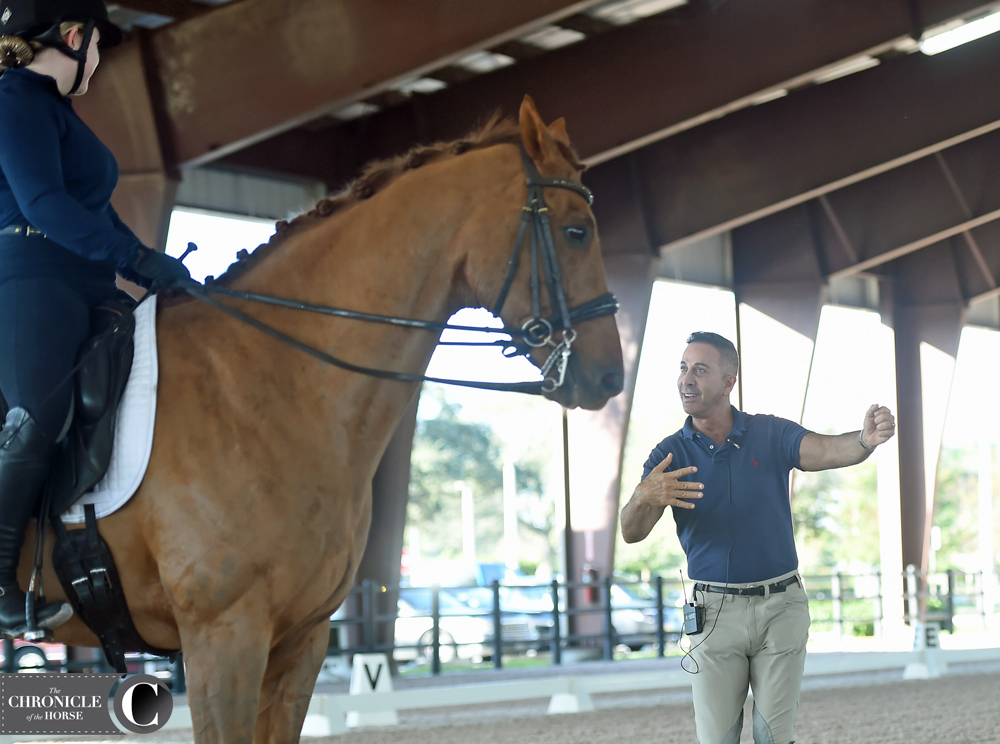
“It’s just like dancing!” Robert Dover compared dressage to the ballroom while explaining the finer points of connection to Kristin Counterman aboard Three Times. Photo by Ann Glavan.
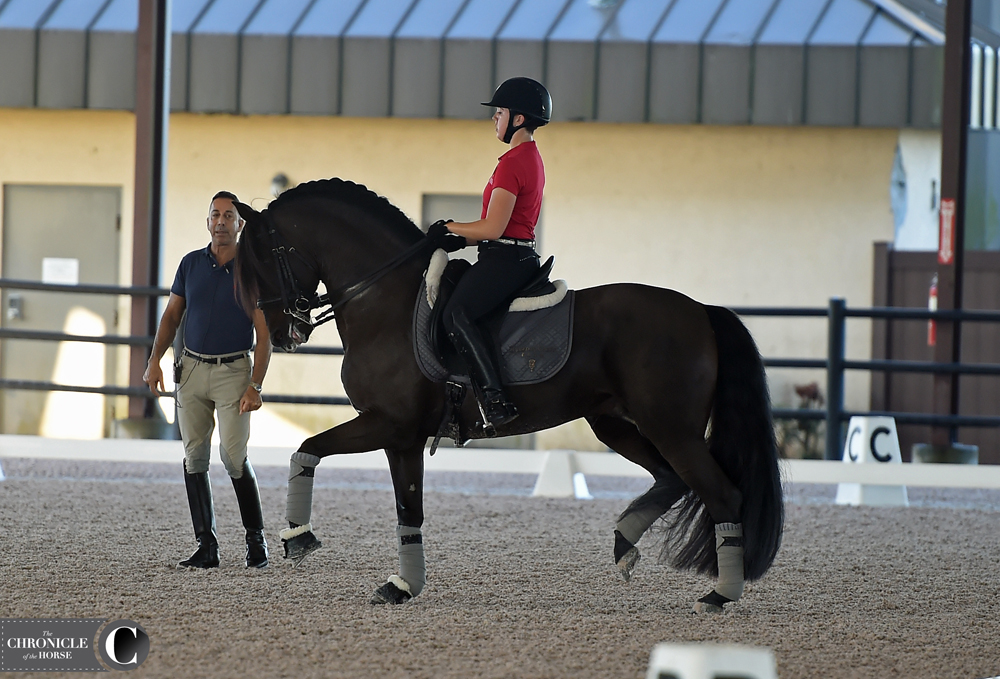
Kerrigan Gulch road the PRE stallion HGF Brio in a lesson with Robert Dover, coaxing some rather impressive collected work from the stud. Photo by Ann Glavan.






